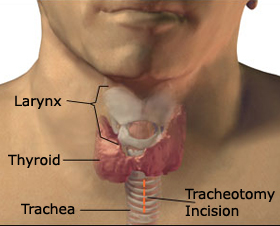Vocal Cord Paralysis
What Is It?
Vocal cord paralysis is a condition in which a person has difficulty speaking because one or both of his vocal cords cannot move. The vocal cords normally vibrate in order to produce voice. This condition can occur in a child or an adult. The most common type is unilateral vocal cord paralysis, in which only one vocal cord has either limited movement or no movement at all. If both vocal cords are immobile, it is called bilateral vocal cord paralysis. This condition will likely require a tracheotomy.
Symptoms
The typical symptoms of vocal cord paralysis will vary, depending on the severity of the condition. While your child may usually yell with all the force of an AIM-9 Sidewinder missile, your home will become markedly quieter if your child has vocal cord paralysis. If he can still speak, you will notice that his voice is hoarse or “breathy.” He will also speak much more softly and he may only be able to produce sounds for a few seconds.
Some people with this condition also have trouble breathing and swallowing properly. You may notice that your child chokes or coughs while he eats. Pneumonia is a possible complication because the airway is not fully protected during swallowing, which can result in liquids and foods being inhaled into the lungs.
Medical Treatments
In mild cases, the child may recover by simply resting his voice. If he experiences severe symptoms he will likely require medical intervention, particularly if he has problems breathing or swallowing. A tracheotomy may be performed if he cannot breathe properly. During this procedure, an incision will be made in the throat and a breathing tube will be inserted.
Otherwise, your child may benefit from an injection of filler material into the vocal cord. This builds up a weak or thin vocal cord, allowing it to vibrate more effectively.
Speech Therapy Treatments
A speech-language pathologist (SLP) will work closely with members of your child’s medical team to determine the best treatments for him. If he has had a tracheotomy, your child will be taught how to work with the breathing tube and inflator cuff in order to communicate.
Even if the child did not require surgery he can benefit from working with an SLP. The SLP will teach your child how to speak without straining his vocal cords. The SLP may use confidential voice therapy, which refers to speaking at a low volume to reduce stress to the vocal cords. Direct voice therapy may also be helpful, in which the SLP addresses various facets of voice production, including resonance, pitch, and breathing. In some cases, a child may find that simply turning his head to a certain direction will result in more effective voice production. Ask the SLP about activities you can do with your child at home to accelerate his progress.





